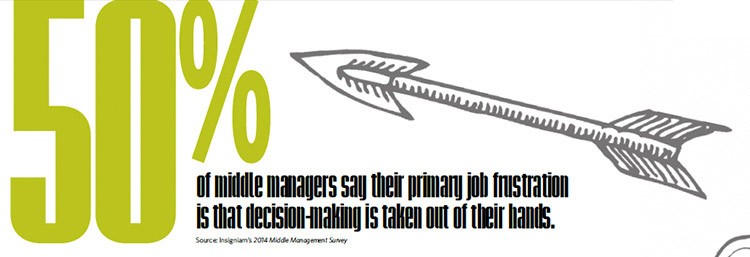Dealing With Decision Rights: Part of Transformational Leadership Development
Bottlenecks, lack of velocity in execution, finger-pointing and stagnation—it’s no secret that even leading companies around the globe struggle with these types of issues. Left untreated, these issues can hobble productivity and chip away at optimal performance. But there is an often-overlooked solution to these common problems—something that can result in profound and meaningful growth, increased effectiveness and heightened morale if implemented correctly.
What’s the solution?
Take decision rights seriously: Methodically determine where and how decisions get made in the organization. When the right people are empowered to make the right kinds of decisions, there is a higher level of focus and better thinking. Bottlenecks disappear, and enterprise transformation and remarkable results emerge with greater velocity.
One of the bigger issues we’ve found is decision rights are assumed to go hand in hand with certain roles and be inherent in a job and position within the corporate hierarchy.
A study published in the Harvard Business Review in 2010 showed that decision effectiveness was correlated to corporate financial returns 95 percent of the time. Furthermore, of the nearly 800 organizations surveyed, those that were most effective at decision-making generated total shareholder returns 6 percentage points higher than less effective firms.
The value is clear. So why do so many companies overlook the importance of decision rights? One of the bigger issues we’ve found is decision rights are assumed to go hand in hand with certain roles and be inherent in a job and position within the corporate hierarchy. The assumption is that the higher the pay grade, the more empowered a person is to make decisions.
That may have been true in the old, hierarchical command-and-control organization where business moved at a measured pace, information rested in the hands of the few, decision-making was top-down and work happened in clearly differentiated silos—but, as we know all too well, times have changed.
Today organizations are highly matrixed and even networked, creating blurred and overlapping lines of accountability. With customer-centricity a key lever for competitive advantage and new technologies giving real-time access to information across the enterprise, decisions can and should happen faster and closer to the customer. And in matrixed organizations, very few decisions can be made in isolation. Therefore in almost any enterprise, effective, fast execution requires collaboration and shared decision-making.
A Change in Organization Design Is a Change in Decision Rights
As the sociologist Max Weber first noted in the early 20th century, enterprises use organizational structure to enhance performance. While there is a cacophony of papers, books, blogs and discussions about the topic of organization design, there is relatively little discourse about the true design function of organizations—the facilitation of the decisions needed to generate value, realize strategies, overcome threats and exploit opportunities.
Because aligning on decision rights is not an easy task, we see very few intentional efforts at addressing this critical aspect of organizational performance. As Harvard Business School Professor Emeritus Michael C. Jensen said in a Harvard Management Update article, “Allocating decision rights in ways that maximize organizational performance is an extraordinarily difficult and controversial management task.”
Take decision rights seriously: Methodically determine where and how decisions get made in the organization. When the right people are empowered to make the right kinds of decisions, there is a higher level of focus and better thinking.
Given this challenge, there is often a serious and detrimental lapse in communication within organizations. The conversation between top executives and their leadership teams to decide who owns the ability to make certain decisions relating to specific parts of the enterprise simply does not take place. The gears of execution, and productivity, stop moving as people look up to their department head or the CEO to act and point the way forward.
Deciding to Decide
Consider a recent example of a CEO who had previously served as his company’s COO. Despite positive intentions, he quickly found that the people who reported to him felt hamstrung because he was heavily involved in operational decisions. It was clear that the range of motion people had to fulfill their responsibilities was far too narrow for them to truly create the greatest value in their roles.
They spent significant time rehashing information for the CEO and relaying plans rather than focusing on moving the business forward. As part of his transition, this CEO commissioned an intensive series of decision rights activities for himself and his direct reports. In this exercise and through a series of facilitated conversations, he intentionally let go of several of the decision rights he was accustomed to having.
This was no easy task: Giving up decision rights is both liberating and terrifying. We all tend to believe our own judgment is superior to someone else’s. Unfortunately, this is a very immature managerial perspective. This particular CEO understood that.
To become pragmatically comfortable with relinquishing some decision rights, he held a series of conversations with his team to negotiate a finite set of decision rights he would retain, as well as how other decision rights would be distributed. His team in turn experienced a greater range of motion and an immediate elevation in performance.
The Middle Manager Blues
One of the biggest errors companies can make is over-centralizing decision rights, Jensen says. Often as a leader, “you think you can make better calls.” But decision rights must be put in the hands of the person possessing the relevant information and line of sight to have the greatest positive impact.
In fact, if you take the time to thoughtfully consider the purpose of executive roles and their true accountabilities, it becomes evident that the CEO and the two levels beneath her or him at dynamic, high-performing organizations must retain very few decision rights.

Why? One key reason is that the purpose of their roles is to ensure the biggest, most sustainable future, set direction and establish the requisite conditions for realizing enterprise intentions. That purpose has a finite set of mission-critical decisions. To have an executive engaged in decisions that don’t align with the purpose of his or her job is a waste of time and money.
Moreover, the highest levels of the organization are often too far removed from the customer or the process to have the perspective and information to make the appropriate decisions. Just as a message is quickly distorted in the “whisper down the lane” game, so does a decision run the risk of becoming erroneous as it moves away from the point of relevant information. Lastly, and perhaps most significantly, moving a decision away from the point of action and execution adds unnecessary time to the execution cycle.
Over-centralizing the decision-making process can also cause tension at the middle-management level. Insigniam’s 2014 Middle Management Survey revealed that 50 percent of middle managers say their primary job frustration is that decision-making is taken out of their hands. This, in turn, created a sense of stress, dissatisfaction and a feeling of loss of power to get work done.
Twenty-five percent of managers involved in such situations said they only intended to stay with their current company until they received a better offer.
Often as a leader, “you think you can make better calls.” But decision rights must be put in the hands of the person possessing the relevant information and line of sight to have the greatest positive impact.
Deciding to Establish Decision Rights
How can organizations best address this key component of performance? Engage people to craft the decision rights needed to fulfill their job. This means having critical conversations where people can answer important questions: 
- What is the purpose of my job? Why have my role?
- What does the organization count on from me—what am I accountable for?
- What decision rights must I retain to deliver on my commitments and the purpose of my job?
- With whom do I share decision rights? What decisions must I be involved in with others—who must I enroll, get input from and notify?
Amazingly, the very act of having someone consider these questions will create a more accountable and effective executive or manager. Because decisions in a complex organization cannot be made in a vacuum, the process of setting these rights must happen in a series of collaborative discussions and negotiations. This in turn solidifies alignment and creates better visibility, which can facilitate faster, better execution.
It takes time and requires candid and uncommon conversations, but what’s the alternative? A slow-moving organization embroiled in constant breakdowns that stem from the fact that people don’t fully understand the purpose of their role or haven’t fully identified what they are accountable for.
Front-Line Decisions
Several leading organizations have identified that empowering teams on the front line with decision rights is a powerful way to stimulate top-line growth, eliminate errors and improve the customer experience.
For instance, Honda Motor Co. embraces the concept of waigaya, which leads directly to “significant improvements in productivity, process, systems and performance that would otherwise have been absent.”
Here’s an example. As Jeffrey Rothfeder discusses in his book Driving Honda: Inside the World’s Most Innovative Car Company, a situation arose at an assembly plant after a worker discovered a problem with a handful of camshafts. Just as managers were planning to ship the affected cars to another factory for servicing—which would have been a costly production setback—an assembly worker decided to halt the assembly line and fix the camshaft without having to remove the major components of the engine.
To truly empower your operational teams, they must know what they are accountable for and retain the right to make decisions to fulfill their goals and responsibilities.
Had that one assembly worker not been given the decision rights at that critical moment and locus of action, “we would be literally sliding engines in and out of cars every day, not knowing [there was a better] way,” said one Honda executive. He continued, “If we don’t include our associates in the decision-making, we’re ignoring potentially our most valuable asset.”
Indeed, human capital is the most valuable asset in a company’s portfolio. Unlocking this competitive advantage means empowering teams across the leadership spectrum to make decisions that will positively impact an organization’s ability to be effective.
To truly empower your operational teams, they must know what they are accountable for Share on X and retain the right to make decisions to fulfill their goals and responsibilities. That is the key to empowerment.
If you want your team to perform optimally, make sure the necessary thought and dialogue occurs to actually give them the access to freedom of movement. Because with great freedom comes great responsibility, a bias toward immediate action—and results.



